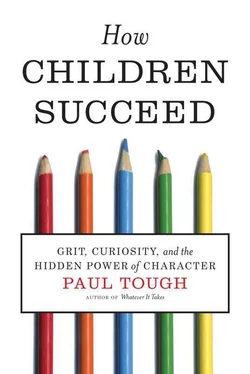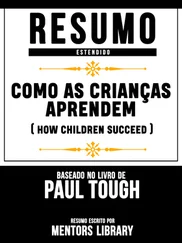Heckman wanted to examine more closely the idea that young people with GEDs were just as well prepared for further academic pursuits as high-school graduates. He analyzed a few large national databases, and he found that in many important ways, the premise was entirely valid. According to their scores on achievement tests, which correlate closely with IQ, GED recipients were every bit as smart as high-school graduates. But when Heckman looked at their path through higher education, he discovered that GED recipients weren’t anything like high-school graduates. At age twenty-two, Heckman found, just 3 percent of GED recipients were enrolled in a four-year university or had completed some kind of post-secondary degree, compared to 46 percent of high-school graduates. In fact, Heckman discovered that when you consider all kinds of important future outcomes—annual income, unemployment rate, divorce rate, use of illegal drugs—GED recipients look exactly like high-school dropouts, despite the fact that they have earned this supposedly valuable extra credential, and despite the fact that they are, on average, considerably more intelligent than high-school dropouts.
From a policy point of view, this was a useful finding, if a depressing one: In the long run, it seemed, as a way to improve your life, the GED was essentially worthless. If anything, it might be having a negative overall effect by inducing young people to drop out of high school. But for Heckman, the results also posed a confounding intellectual puzzle. Like most economists, Heckman had believed that cognitive ability was the single most reliable determinant of how a person’s life would turn out. Now he had discovered a group—GED holders—whose good test scores didn’t seem to have any positive effect on their lives.
What was missing from the equation, Heckman concluded, were the psychological traits that had allowed the high-school graduates to make it through school. Those traits—an inclination to persist at a boring and often unrewarding task; the ability to delay gratification; the tendency to follow through on a plan—also turned out to be valuable in college, in the workplace, and in life generally. As Heckman explained in one paper: “Inadvertently, the GED has become a test that separates bright but nonpersistent and undisciplined dropouts from other dropouts.” GED holders, he wrote, “are ‘wise guys’ who lack the ability to think ahead, persist in tasks, or to adapt to their environments.”
What the GED study didn’t give Heckman was any indication of whether it was possible to help children develop those so-called soft skills. His search for an answer to that question led him, almost a decade ago, to Ypsilanti, Michigan, an old industrial town west of Detroit. In the mid-1960s, in the early days of the War on Poverty, a group of child psychologists and education researchers undertook an experiment there, recruiting low-income, low-IQ parents from the town’s black neighborhoods to sign up their three- and four-year-old kids for the Perry Preschool. The recruited children were divided randomly into a treatment group and a control group. Children in the treatment group were admitted to Perry, a high-quality, two-year preschool program, and kids in the control group were left to fend for themselves. And then the children were tracked—not just for a year or two, but for decades, in an ongoing study that is intended to follow them for the rest of their lives. The subjects are now in their forties, which means that researchers have been able to trace the effects of the Perry intervention well into adulthood.
The Perry Preschool Project is famous in social science circles, and Heckman had encountered it, glancingly, several times before in his career. As a case for early-childhood intervention, the experiment had always been considered something of a failure. The treatment children did do significantly better on cognitive tests while attending the preschool and for a year or two afterward, but the gains did not last, and by the time the treatment children were in the third grade, their IQ scores were no better than the control group’s. But when Heckman and other researchers looked at the long-term results of Perry, the data appeared more promising. It was true that the Perry kids hadn’t experienced lasting IQ benefits. But something important had happened to them in preschool, and whatever it was, the positive effects resonated for decades. Compared to the control group, the Perry students were more likely to graduate from high school, more likely to be employed at age twenty-seven, more likely to be earning more than twenty-five thousand dollars a year at age forty, less likely ever to have been arrested, and less likely to have spent time on welfare.
Heckman began to rummage more deeply into the Perry study, and he learned that in the 1960s and 1970s, researchers had collected some data on the students that had never been analyzed: reports from teachers in elementary school rating both the treatment and the control children on “personal behavior” and “social development.” The first term tracked how often each student swore, lied, stole, or was absent or late; the second one rated each student’s level of curiosity as well as his or her relationships with classmates and teachers. Heckman labeled these noncognitive skills, because they were entirely distinct from IQ. And after three years of careful analysis, Heckman and his researchers were able to ascertain that those noncognitive factors, such as curiosity, self-control, and social fluidity, were responsible for as much as two-thirds of the total benefit that Perry gave its students.
The Perry Preschool Project, in other words, worked entirely differently than everyone had believed. The goodhearted educators who set it up in the sixties thought that they were creating a program to raise the intelligence of low-income children; they, like everyone else, believed that was the way to help poor kids get ahead in America. Surprise number one was that they created a program that didn’t do much in the long term for IQ but did improve behavior and social skills. Surprise number two was that it helped anyway—for the kids in Ypsilanti, those skills and the underlying traits they reflected turned out to be very valuable indeed.
In the course of reporting this book, I spent a lot of time discussing success and skills with a variety of economists, psychologists, and neuroscientists, many of whom were linked to James Heckman by one or two degrees of separation. But what grounded their research for me, what brought it to life and gave it meaning, was a different kind of reporting that I was doing at the same time, in public schools and pediatric clinics and fast-food restaurants, where I was talking with young people whose lives embodied and illustrated, in one way or another, the complex question of which children succeed and how.
Take Kewauna Lerma. When I met her, in the winter of 2010, she was living on the South Side of Chicago—not too far, as it turned out, from the University of Chicago campus where Heckman spent his days. Kewauna had been born on the South Side, into poverty, seventeen years earlier, the second daughter of a mother who had her first child, Kewauna’s older sister, when she was still a teenager. Kewauna had a rootless, unsettled childhood. When she was a baby, her mother moved the family to Mississippi, then to Minnesota, then back to Chicago as she drifted in and out of relationships and in and out of trouble. When things were bad, the family spent periods in shelters or bouncing from one friend’s couch to another’s. Sometimes Kewauna’s great-grandmother would take the kids for a while and let Kewauna’s mother try to sort out her life on her own.
“I didn’t really have a family family,” Kewauna told me the first time we spoke. We were sitting in a coffee shop in the Kenwood neighborhood. It was the middle of a harsh Chicago winter, and the windows were fogged over. Kewauna has dark skin, big, sympathetic eyes, and straight, dark hair, and she sat forward, warming her hands on a foam-topped mug of hot chocolate. “I was scattered all over the place, no father, with my grandma sometimes. It was all messed up. Jacked up.”
Читать дальше



![Коринн МакКей - How to Succeed as a Freelance Translator [calibre 3.46.0]](/books/402693/korinn-makkej-how-to-succeed-as-a-freelance-transl-thumb.webp)








